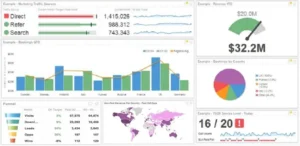Businesses routinely make several customizations to their Salesforce to align it with their specific business requirements. It’s never a one-size-fits-all situation. Customization requires input from all departments that will be using the platform. Here are a few customizations we often guide customers through at Cloud Next Level.
- Data Model Customization: Modifying the standard objects, fields, and relationships or creating custom objects to match the business data structure.
- Workflow and Process Automation: Designing and configuring workflows, approval processes, and automation rules to streamline business processes and automate repetitive tasks.
- Custom Fields and Page Layouts: Adding custom fields to capture unique data points and rearranging page layouts to present relevant information in a user-friendly manner.
- Reports and Dashboards: Creating custom reports and dashboards to visualize data, track key metrics, and gain insights into sales, marketing, and customer service performance.
- Custom Objects and Applications: Building custom objects and applications to manage specific business processes or vertical-specific needs not covered by standard Salesforce functionality.
- User Permissions and Roles: Defining user roles, profiles, and permissions to control access to data and features based on the organizational hierarchy and job responsibilities.
- Integration with External Systems: Integrating Salesforce with other business systems, such as ERP or marketing automation platforms, to enable seamless data flow and process synchronization.
- Email Templates and Workflow: Creating personalized email templates and configuring automated email workflows for various customer journey stages.
- Custom Reports and Dashboards: Develop tailored reports and dashboards to monitor and analyze specific business metrics and performance indicators.
- Mobile Customization: Optimizing Salesforce for mobile devices by configuring mobile layouts, adding mobile-specific features, and ensuring a responsive user experience.
In a perfect world, these customizations adapt Salesforce to the unique needs of each business, elevate productivity, improve data management, and enable efficient sales, marketing, and customer service activities.
Can Salesforce be over-customized?
Yes, Salesforce can be over-customized. While customization is a powerful feature of Salesforce that allows businesses to tailor the CRM to their needs, excessive customization can have pitfalls.
- Complexity and Maintenance: The more customizations implemented, the more complex the system becomes. Excessive customizations can lead to a convoluted data model, intricate workflows, and a high number of custom fields and objects. This complexity can make the system harder to maintain, troubleshoot, and upgrade. It also increases costs.
- User Adoption Challenges: Introducing too many customizations can confuse and overwhelm users, especially those unfamiliar with the system. User adoption may suffer if the CRM becomes overly complex, leading to resistance and a lack of engagement.
- Upgrades and Compatibility Issues: When Salesforce releases new updates and features, excessive customizations may not seamlessly align with these changes. This can result in compatibility issues, requiring additional time and effort to modify and adapt customizations during system upgrades, which also increases costs.
- Increased Development Time and Costs: Implementing and maintaining extensive customizations can require significant development effort, translating into increased costs. Additionally, complex customizations usually require ongoing development support, adding to the expenses even more.
- Dependency on Custom Code: Extensive customization often involves writing custom code, such as Apex or Visualforce, to meet specific business requirements. Relying heavily on custom code can introduce additional complexity, maintenance challenges, and possible risks if not properly managed. Remember the Salesforce mantra: clicks, not code.
To avoid over customization, businesses should carefully evaluate their needs, prioritize customizations based on their impact and necessity, and strike a balance between customization and the out-of-the-box capabilities of Salesforce. It is crucial to consider long-term maintainability, scalability, user experience, and the potential impact on future system upgrades.







